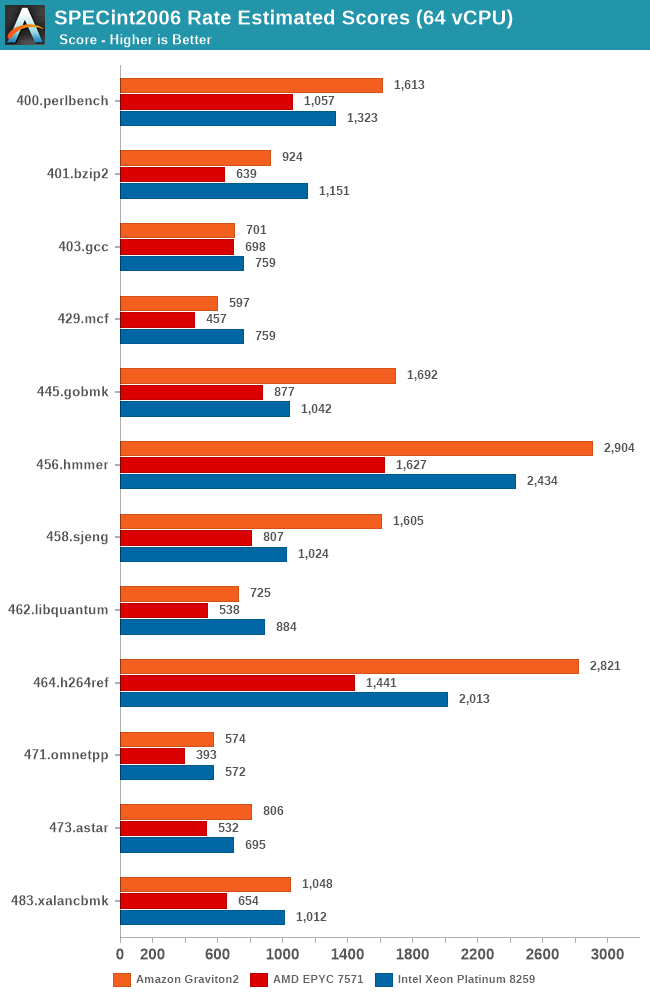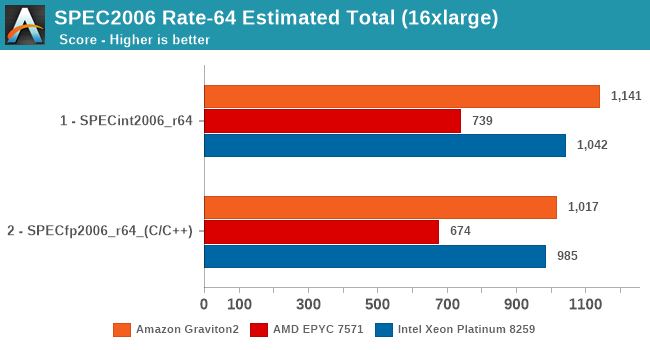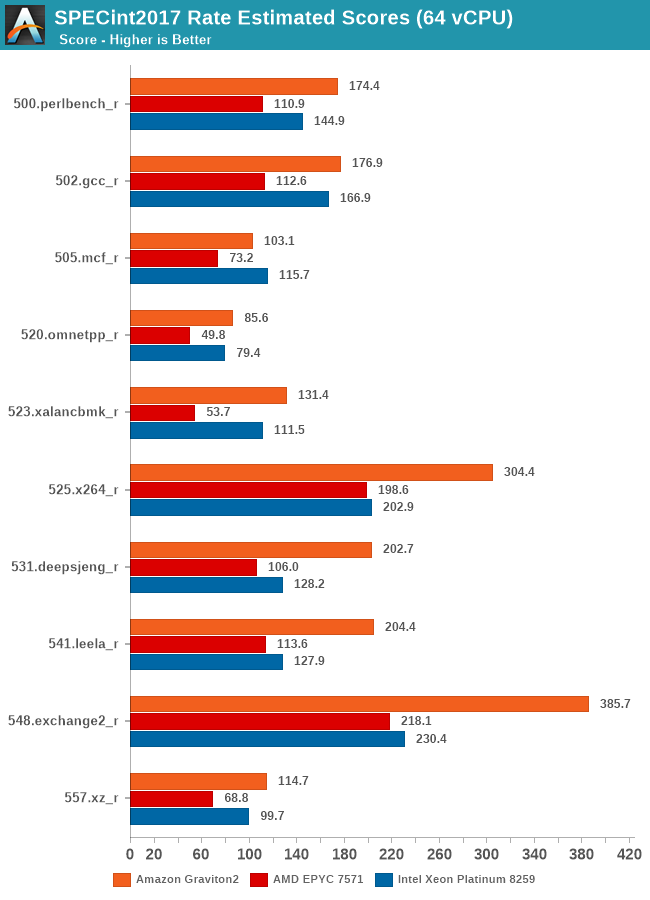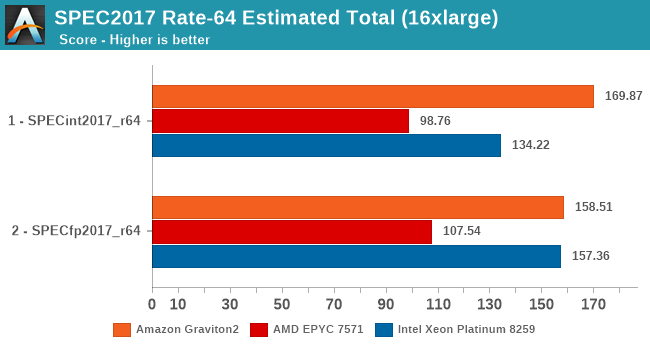Amazon's Arm-based Graviton2 Against AMD and Intel: Comparing Cloud Compute
by Andrei Frumusanu on March 10, 2020 8:30 AM EST- Posted in
- Servers
- CPUs
- Cloud Computing
- Amazon
- AWS
- Neoverse N1
- Graviton2
SPEC - MT Performance (16xlarge 64vCPU)
While the core scaling figures are interesting from an academical standpoint, what’s even more interesting is seeing the absolute throughput numbers compared to the competition. We’re starting off with SPECrate results with 64-rate runs, fully utilising the vCPUs of the EC2 16xlarge instances.
Again, there’s the conundrum of the apples-and-oranges comparison between the Graviton2’s 64 physical cores versus the 32 cores plus SMT setups of the AMD and Intel platforms, but again, that’s how Amazon is positioning these systems in terms of throughput capacity and instance pricing. You could argue that if you can parallelise your workload above a certain amount of threads, it doesn’t matter on whether you can achieve the higher throughput through more cores or through mechanisms such as SMT. Remember, when talking about silicon die area, you could at minimum probably fit 2 N1 cores in the same area than an AMD Zen core or an Intel core (probably an even higher number in the latter comparison).

The Graviton2’s performance is absolutely impressive across the board, beating the Intel Cascade Lake system by quite larger margins in a lot of the workloads. AMD’s Epyc system here doesn’t fare well at all and is showing its age.

It’s particularly in the non-memory bound workloads that the Graviton2 manages to position itself significantly ahead, and here the advantage of having a two-fold physical core lead with essentially double the execution resources shows its benefits.

In the overall SPECrate2006 results, the Graviton2 is shy of Arm’s projection of a 1300 score, but again the Amazon chip does clock in a bit lower and has less cache than what Arm had envisioned in their presentations a year ago.
Nevertheless, the Graviton2 has the performance lead here even against the Intel Cascade Lake based EC2 instances, which is quite surprising given the latter’s cost structure, and indicator of what to come later in the cost analysis.

Arm’s physical core count advantage here continues to show in the execution intensive workloads of SPECint2017, showcasing some very large performance leads in many workloads. The performance leap on important workloads such as 502.gcc again isn’t too great over the Intel system for example – Amazon and Arm definitely could do better here if the chip would have had more cache available.

In SPECfp2017, there’s more workloads in which the Xeon system’s 2-socket setup with a 50% memory channel advantage does show up, able to result in more available bandwidth and thus give the more memory intensive workloads in this suite a good performance advantage over the Graviton2 system. Still, the Arm chip fares very competitively and does put the older AMD EPYC processor in its place, and yes again, we have to remind ourselves that things would be quite different here if we’d be able to include Rome in our charts.

Overall, the Graviton2 system has an undisputed lead in the SPECint2017 suite, whilst just edging out on average the Xeon system in the FP suite, only losing out in situations where the Xeon’s higher memory bandwidth comes at play.










96 Comments
View All Comments
Wilco1 - Wednesday, March 11, 2020 - link
It's funny you mention optimized math libraries. The reality is that Arm has freely published generic C math libraries which beat handwritten x86 assembler implementations: https://github.com/ARM-software/optimized-routinesThe GLIBC version installed in Graviton 2 is relatively old, so doesn't have this new math code yet (while Android and LLVM libraries do), and this explains why GCC SPECFP scores are relatively low.
senttoschool - Tuesday, March 10, 2020 - link
Can we conclude that ARM is going to destroy AMD and Intel in the server space within the next 5 years?RSAUser - Tuesday, March 10, 2020 - link
No, but they're going to reduce the excessive margins.rogerdpack - Monday, February 14, 2022 - link
Wish they'd release it to more than just datacenters though...jeffsci - Tuesday, March 10, 2020 - link
"I didn’t have a proper good multi-core bandwidth test available in my toolset (going to have to write one), so fell back to Timo Bingmann’s PMBW test for some quick numbers on the memory bandwidth scaling of the Graviton2."The canonical benchmark for memory bandwidth, which supports OpenMP for multithreading, is McCalpin's STREAM (https://www.cs.virginia.edu/stream/).
Andrei Frumusanu - Tuesday, March 10, 2020 - link
I'm not a big fan of it, particularly because of OMP, one can do much better.kliend - Tuesday, March 10, 2020 - link
I have a question I did not find addressed in the article.Will Amazon/AWS offer this instance in Linux only or do they also run Windows?
Andrei Frumusanu - Tuesday, March 10, 2020 - link
The preview images are all Linux, I'm not aware of their plans on Windows.Korguz's Mom - Tuesday, March 10, 2020 - link
Probably not - if you need a Windows image I would imagine they would push you towards the Intel or AMD service and not the ARM service - yes Windows Server runs on ARM but unless you were testing Windows applications / services specifically for ARM - there would be no benefit.Korguz - Wednesday, March 11, 2020 - link
FYI, my mom died of cancer 4 years ago, i hope you are happy and proud of your self. you are scum